Financial Accounting 1 Report: Bookkeeping, Statements, and Analysis
VerifiedAdded on 2023/01/10
|21
|4289
|36
Report
AI Summary
This report delves into the core concepts of financial accounting, encompassing two key scenarios. The first scenario examines business transactions, differentiating between internal and external types, and exploring single and double-entry bookkeeping systems. It explains the significance of trial balances and provides practical examples of journal entries, ledger accounts, and trial balances. Furthermore, the report clarifies the distinctions between financial reports and statements, outlining fundamental accounting principles like the monetary unit assumption, going concern, and the matching principle. The second scenario shifts focus to bank reconciliation, detailing the process of aligning company records with bank statements, and explaining control accounts and suspense accounts. The report also includes illustrative examples, such as profit and loss accounts, and balance sheets, thereby offering a comprehensive understanding of financial accounting practices. Finally, it provides an analysis of income statements and balance sheets.
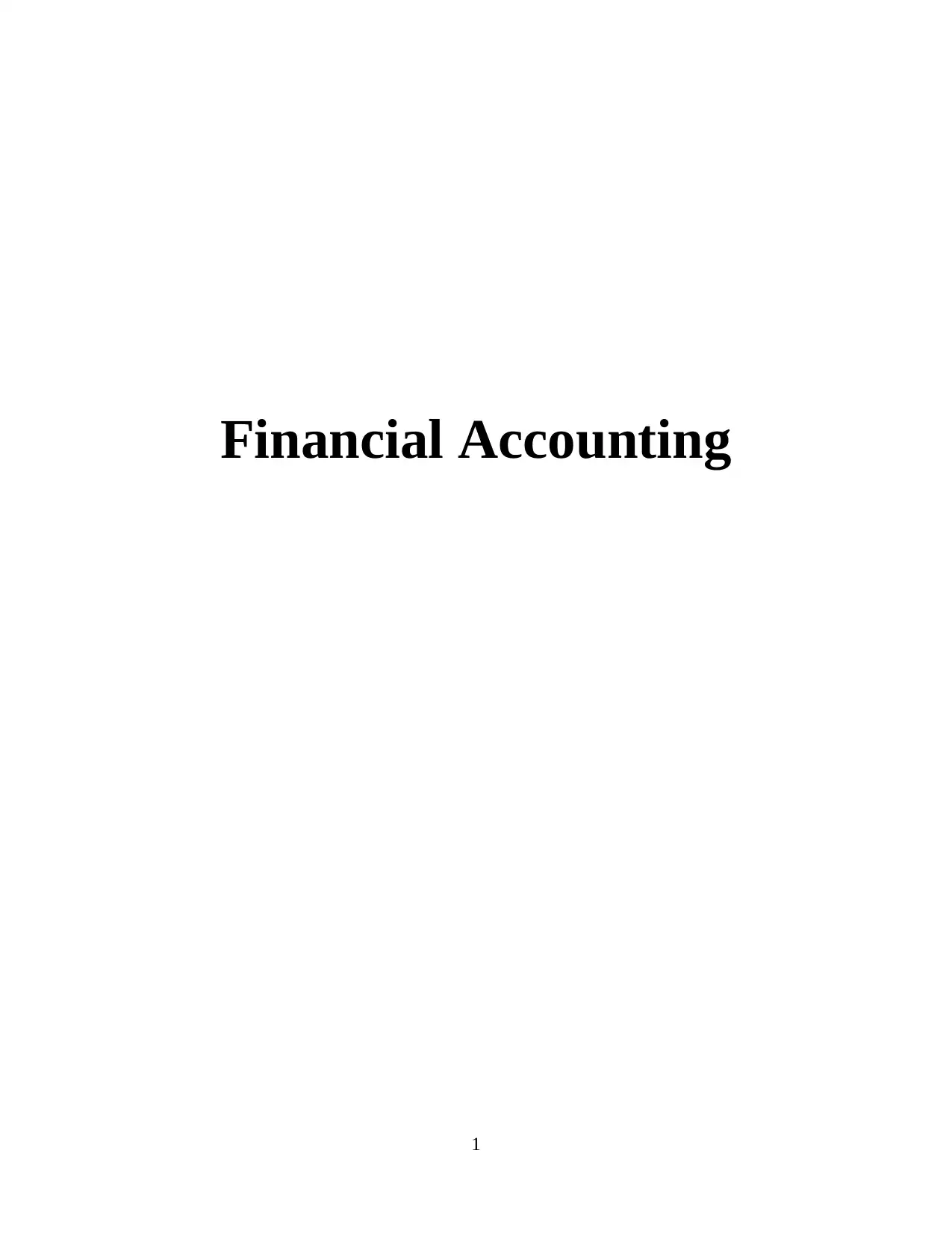
Financial Accounting
1
1
Paraphrase This Document
Need a fresh take? Get an instant paraphrase of this document with our AI Paraphraser
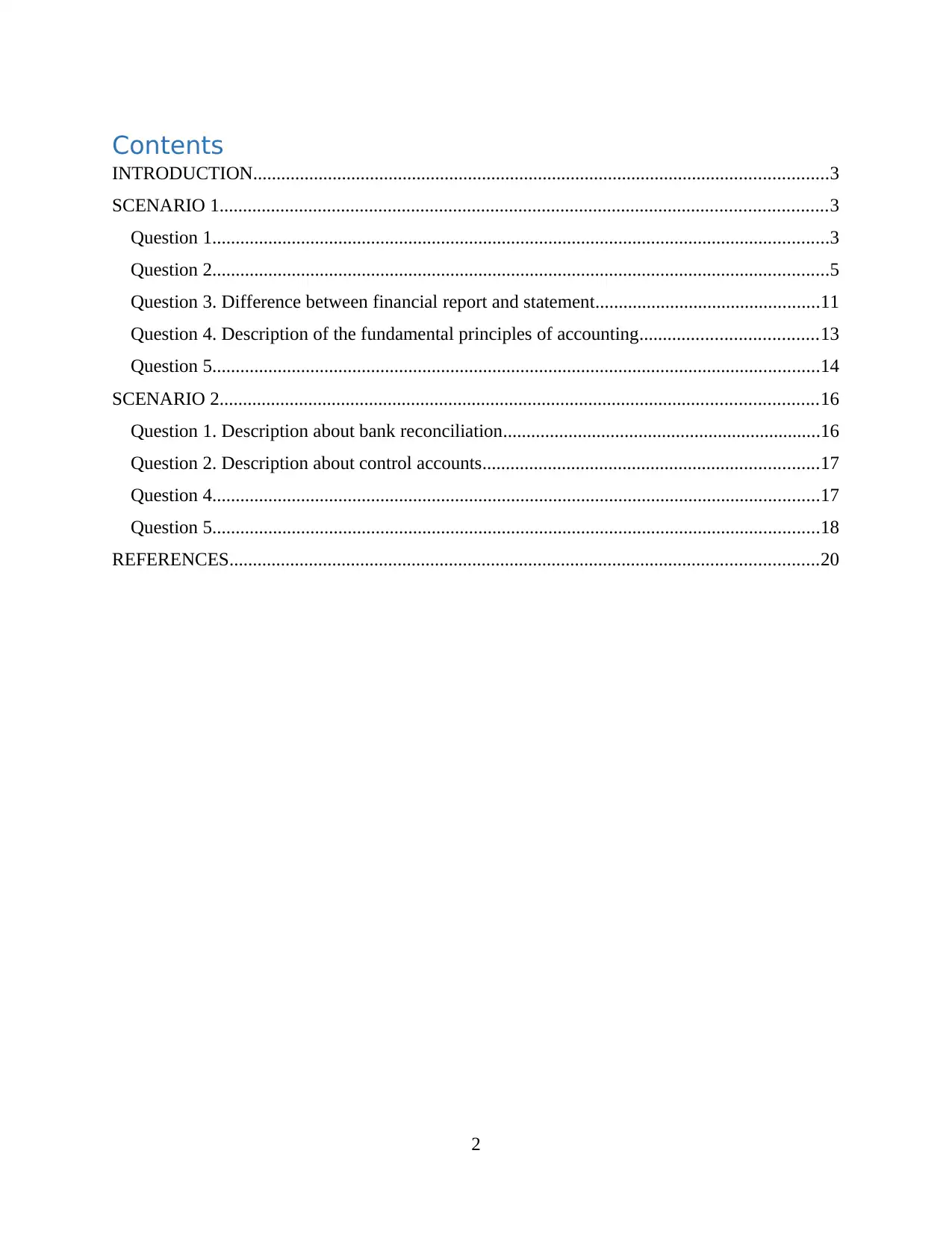
Contents
INTRODUCTION...........................................................................................................................3
SCENARIO 1..................................................................................................................................3
Question 1....................................................................................................................................3
Question 2....................................................................................................................................5
Question 3. Difference between financial report and statement................................................11
Question 4. Description of the fundamental principles of accounting......................................13
Question 5..................................................................................................................................14
SCENARIO 2................................................................................................................................16
Question 1. Description about bank reconciliation....................................................................16
Question 2. Description about control accounts........................................................................17
Question 4..................................................................................................................................17
Question 5..................................................................................................................................18
REFERENCES..............................................................................................................................20
2
INTRODUCTION...........................................................................................................................3
SCENARIO 1..................................................................................................................................3
Question 1....................................................................................................................................3
Question 2....................................................................................................................................5
Question 3. Difference between financial report and statement................................................11
Question 4. Description of the fundamental principles of accounting......................................13
Question 5..................................................................................................................................14
SCENARIO 2................................................................................................................................16
Question 1. Description about bank reconciliation....................................................................16
Question 2. Description about control accounts........................................................................17
Question 4..................................................................................................................................17
Question 5..................................................................................................................................18
REFERENCES..............................................................................................................................20
2
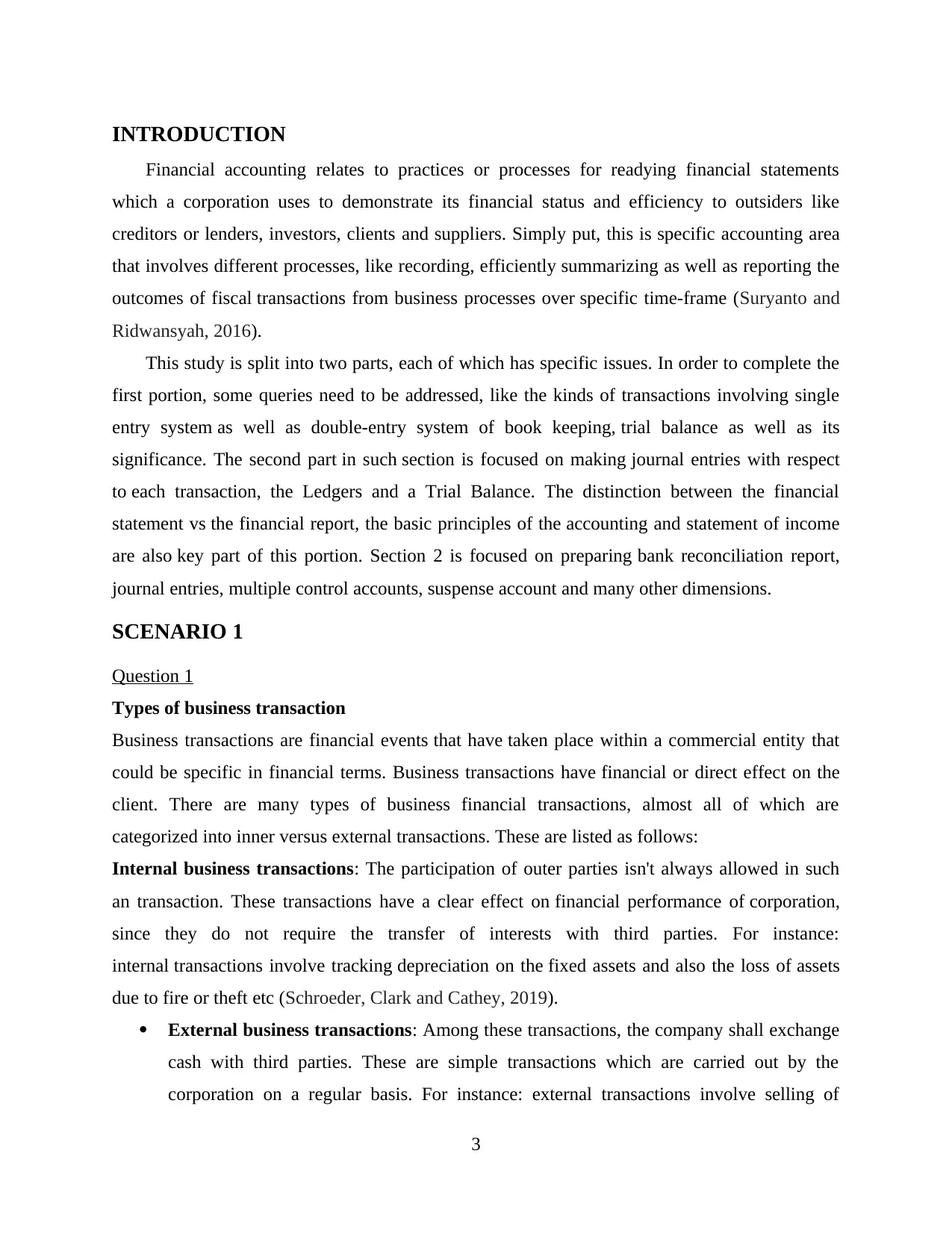
INTRODUCTION
Financial accounting relates to practices or processes for readying financial statements
which a corporation uses to demonstrate its financial status and efficiency to outsiders like
creditors or lenders, investors, clients and suppliers. Simply put, this is specific accounting area
that involves different processes, like recording, efficiently summarizing as well as reporting the
outcomes of fiscal transactions from business processes over specific time-frame (Suryanto and
Ridwansyah, 2016).
This study is split into two parts, each of which has specific issues. In order to complete the
first portion, some queries need to be addressed, like the kinds of transactions involving single
entry system as well as double-entry system of book keeping, trial balance as well as its
significance. The second part in such section is focused on making journal entries with respect
to each transaction, the Ledgers and a Trial Balance. The distinction between the financial
statement vs the financial report, the basic principles of the accounting and statement of income
are also key part of this portion. Section 2 is focused on preparing bank reconciliation report,
journal entries, multiple control accounts, suspense account and many other dimensions.
SCENARIO 1
Question 1
Types of business transaction
Business transactions are financial events that have taken place within a commercial entity that
could be specific in financial terms. Business transactions have financial or direct effect on the
client. There are many types of business financial transactions, almost all of which are
categorized into inner versus external transactions. These are listed as follows:
Internal business transactions: The participation of outer parties isn't always allowed in such
an transaction. These transactions have a clear effect on financial performance of corporation,
since they do not require the transfer of interests with third parties. For instance:
internal transactions involve tracking depreciation on the fixed assets and also the loss of assets
due to fire or theft etc (Schroeder, Clark and Cathey, 2019).
External business transactions: Among these transactions, the company shall exchange
cash with third parties. These are simple transactions which are carried out by the
corporation on a regular basis. For instance: external transactions involve selling of
3
Financial accounting relates to practices or processes for readying financial statements
which a corporation uses to demonstrate its financial status and efficiency to outsiders like
creditors or lenders, investors, clients and suppliers. Simply put, this is specific accounting area
that involves different processes, like recording, efficiently summarizing as well as reporting the
outcomes of fiscal transactions from business processes over specific time-frame (Suryanto and
Ridwansyah, 2016).
This study is split into two parts, each of which has specific issues. In order to complete the
first portion, some queries need to be addressed, like the kinds of transactions involving single
entry system as well as double-entry system of book keeping, trial balance as well as its
significance. The second part in such section is focused on making journal entries with respect
to each transaction, the Ledgers and a Trial Balance. The distinction between the financial
statement vs the financial report, the basic principles of the accounting and statement of income
are also key part of this portion. Section 2 is focused on preparing bank reconciliation report,
journal entries, multiple control accounts, suspense account and many other dimensions.
SCENARIO 1
Question 1
Types of business transaction
Business transactions are financial events that have taken place within a commercial entity that
could be specific in financial terms. Business transactions have financial or direct effect on the
client. There are many types of business financial transactions, almost all of which are
categorized into inner versus external transactions. These are listed as follows:
Internal business transactions: The participation of outer parties isn't always allowed in such
an transaction. These transactions have a clear effect on financial performance of corporation,
since they do not require the transfer of interests with third parties. For instance:
internal transactions involve tracking depreciation on the fixed assets and also the loss of assets
due to fire or theft etc (Schroeder, Clark and Cathey, 2019).
External business transactions: Among these transactions, the company shall exchange
cash with third parties. These are simple transactions which are carried out by the
corporation on a regular basis. For instance: external transactions involve selling of
3
⊘ This is a preview!⊘
Do you want full access?
Subscribe today to unlock all pages.

Trusted by 1+ million students worldwide
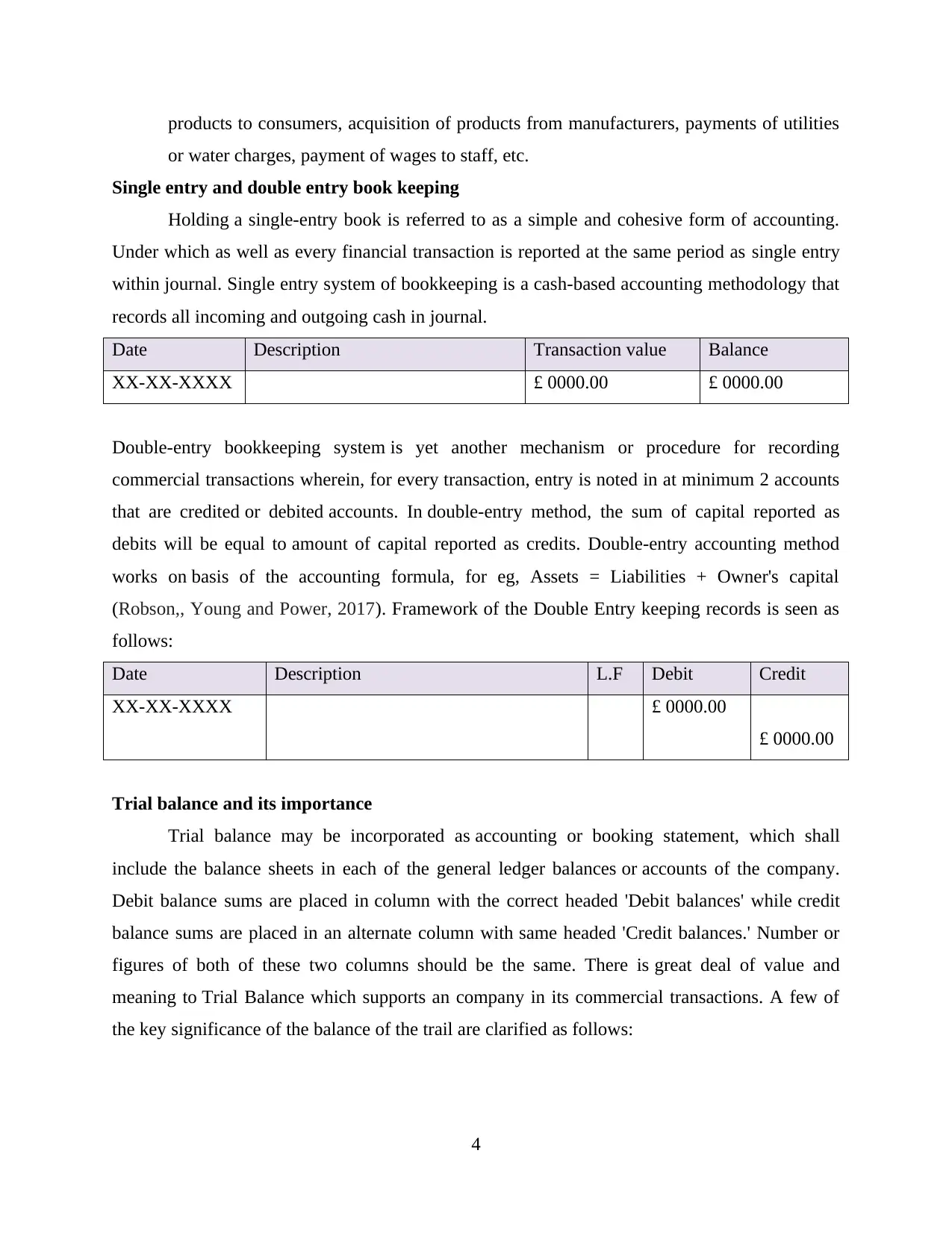
products to consumers, acquisition of products from manufacturers, payments of utilities
or water charges, payment of wages to staff, etc.
Single entry and double entry book keeping
Holding a single-entry book is referred to as a simple and cohesive form of accounting.
Under which as well as every financial transaction is reported at the same period as single entry
within journal. Single entry system of bookkeeping is a cash-based accounting methodology that
records all incoming and outgoing cash in journal.
Date Description Transaction value Balance
XX-XX-XXXX £ 0000.00 £ 0000.00
Double-entry bookkeeping system is yet another mechanism or procedure for recording
commercial transactions wherein, for every transaction, entry is noted in at minimum 2 accounts
that are credited or debited accounts. In double-entry method, the sum of capital reported as
debits will be equal to amount of capital reported as credits. Double-entry accounting method
works on basis of the accounting formula, for eg, Assets = Liabilities + Owner's capital
(Robson,, Young and Power, 2017). Framework of the Double Entry keeping records is seen as
follows:
Date Description L.F Debit Credit
XX-XX-XXXX £ 0000.00
£ 0000.00
Trial balance and its importance
Trial balance may be incorporated as accounting or booking statement, which shall
include the balance sheets in each of the general ledger balances or accounts of the company.
Debit balance sums are placed in column with the correct headed 'Debit balances' while credit
balance sums are placed in an alternate column with same headed 'Credit balances.' Number or
figures of both of these two columns should be the same. There is great deal of value and
meaning to Trial Balance which supports an company in its commercial transactions. A few of
the key significance of the balance of the trail are clarified as follows:
4
or water charges, payment of wages to staff, etc.
Single entry and double entry book keeping
Holding a single-entry book is referred to as a simple and cohesive form of accounting.
Under which as well as every financial transaction is reported at the same period as single entry
within journal. Single entry system of bookkeeping is a cash-based accounting methodology that
records all incoming and outgoing cash in journal.
Date Description Transaction value Balance
XX-XX-XXXX £ 0000.00 £ 0000.00
Double-entry bookkeeping system is yet another mechanism or procedure for recording
commercial transactions wherein, for every transaction, entry is noted in at minimum 2 accounts
that are credited or debited accounts. In double-entry method, the sum of capital reported as
debits will be equal to amount of capital reported as credits. Double-entry accounting method
works on basis of the accounting formula, for eg, Assets = Liabilities + Owner's capital
(Robson,, Young and Power, 2017). Framework of the Double Entry keeping records is seen as
follows:
Date Description L.F Debit Credit
XX-XX-XXXX £ 0000.00
£ 0000.00
Trial balance and its importance
Trial balance may be incorporated as accounting or booking statement, which shall
include the balance sheets in each of the general ledger balances or accounts of the company.
Debit balance sums are placed in column with the correct headed 'Debit balances' while credit
balance sums are placed in an alternate column with same headed 'Credit balances.' Number or
figures of both of these two columns should be the same. There is great deal of value and
meaning to Trial Balance which supports an company in its commercial transactions. A few of
the key significance of the balance of the trail are clarified as follows:
4
Paraphrase This Document
Need a fresh take? Get an instant paraphrase of this document with our AI Paraphraser
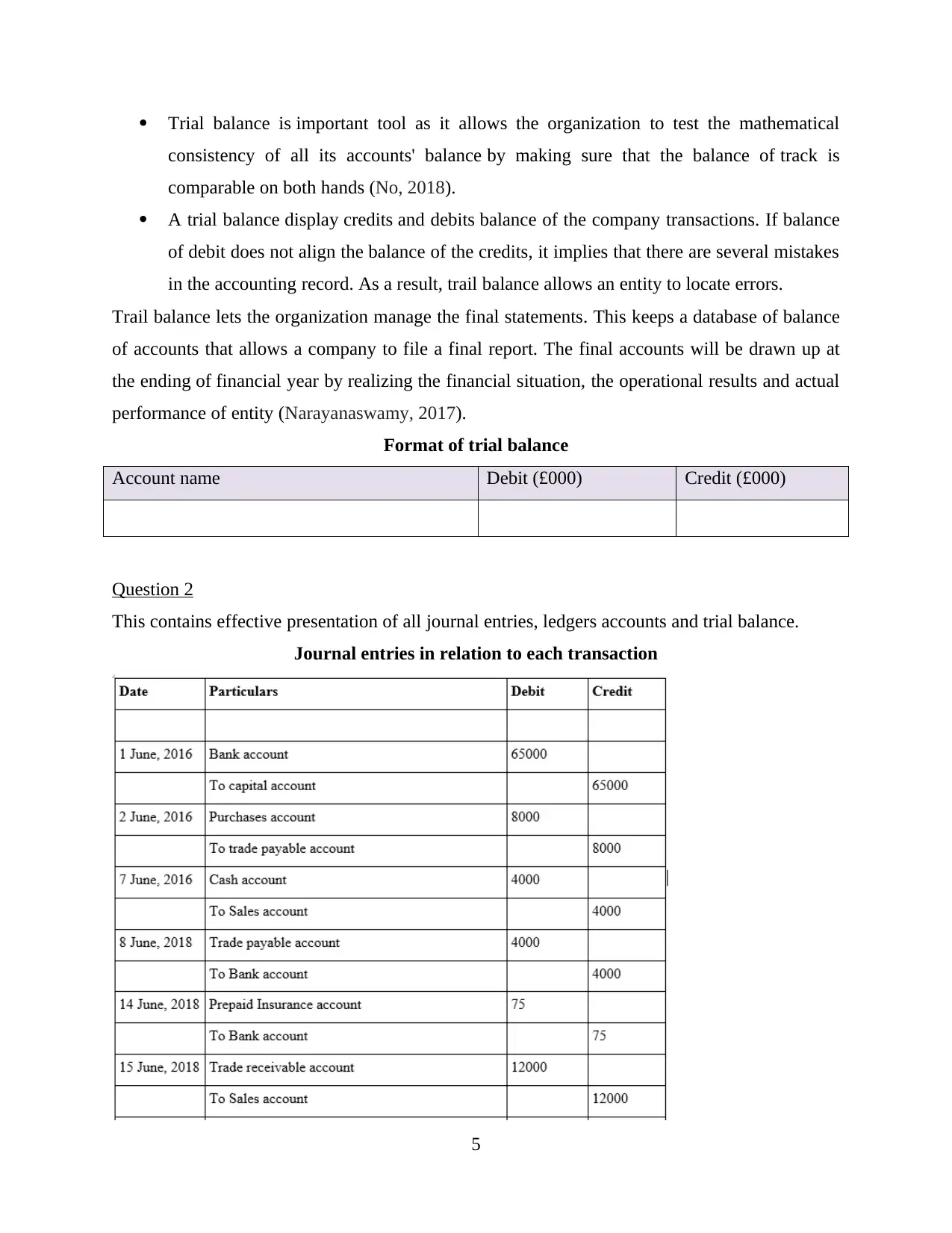
Trial balance is important tool as it allows the organization to test the mathematical
consistency of all its accounts' balance by making sure that the balance of track is
comparable on both hands (No, 2018).
A trial balance display credits and debits balance of the company transactions. If balance
of debit does not align the balance of the credits, it implies that there are several mistakes
in the accounting record. As a result, trail balance allows an entity to locate errors.
Trail balance lets the organization manage the final statements. This keeps a database of balance
of accounts that allows a company to file a final report. The final accounts will be drawn up at
the ending of financial year by realizing the financial situation, the operational results and actual
performance of entity (Narayanaswamy, 2017).
Format of trial balance
Account name Debit (£000) Credit (£000)
Question 2
This contains effective presentation of all journal entries, ledgers accounts and trial balance.
Journal entries in relation to each transaction
5
consistency of all its accounts' balance by making sure that the balance of track is
comparable on both hands (No, 2018).
A trial balance display credits and debits balance of the company transactions. If balance
of debit does not align the balance of the credits, it implies that there are several mistakes
in the accounting record. As a result, trail balance allows an entity to locate errors.
Trail balance lets the organization manage the final statements. This keeps a database of balance
of accounts that allows a company to file a final report. The final accounts will be drawn up at
the ending of financial year by realizing the financial situation, the operational results and actual
performance of entity (Narayanaswamy, 2017).
Format of trial balance
Account name Debit (£000) Credit (£000)
Question 2
This contains effective presentation of all journal entries, ledgers accounts and trial balance.
Journal entries in relation to each transaction
5
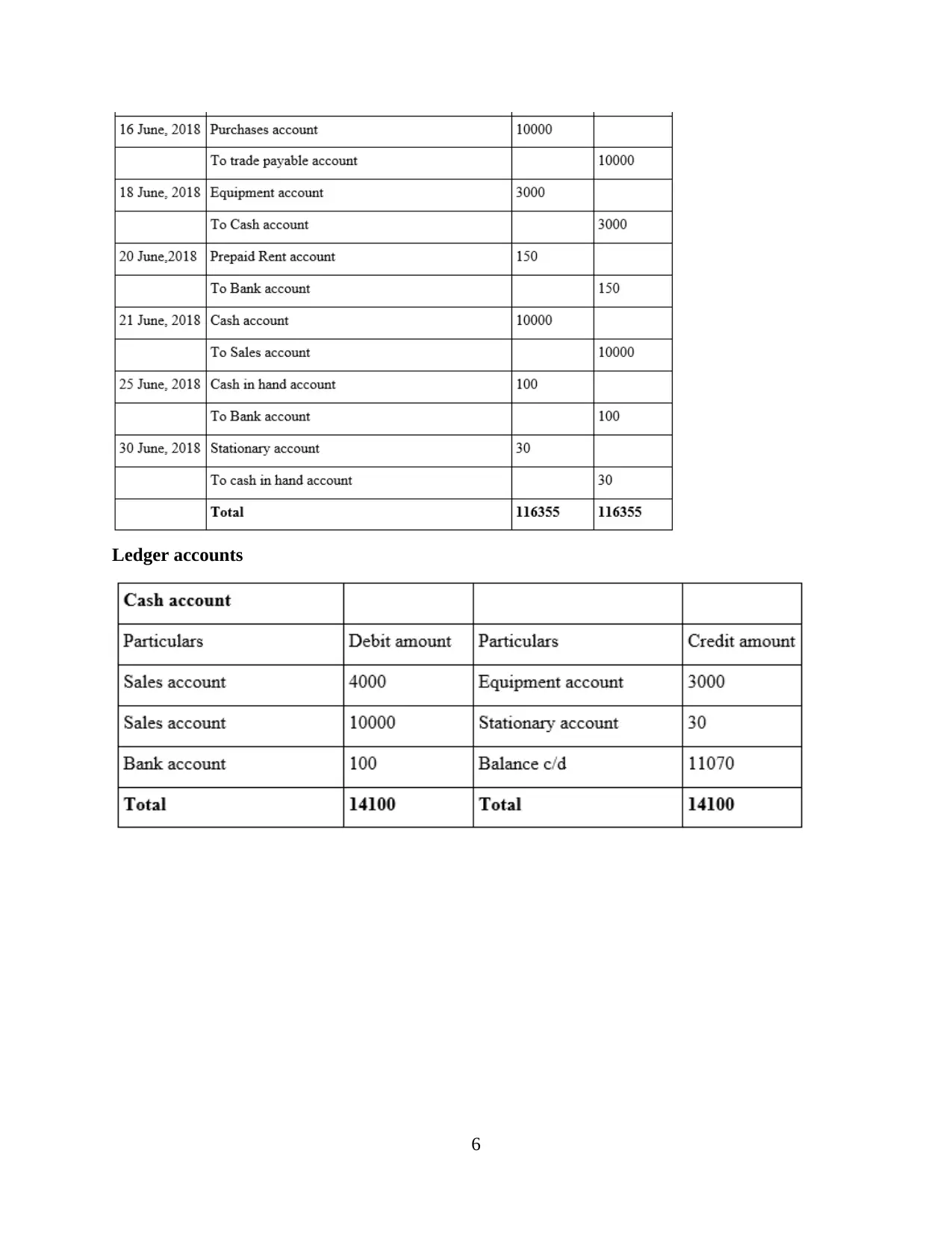
Ledger accounts
6
6
⊘ This is a preview!⊘
Do you want full access?
Subscribe today to unlock all pages.

Trusted by 1+ million students worldwide
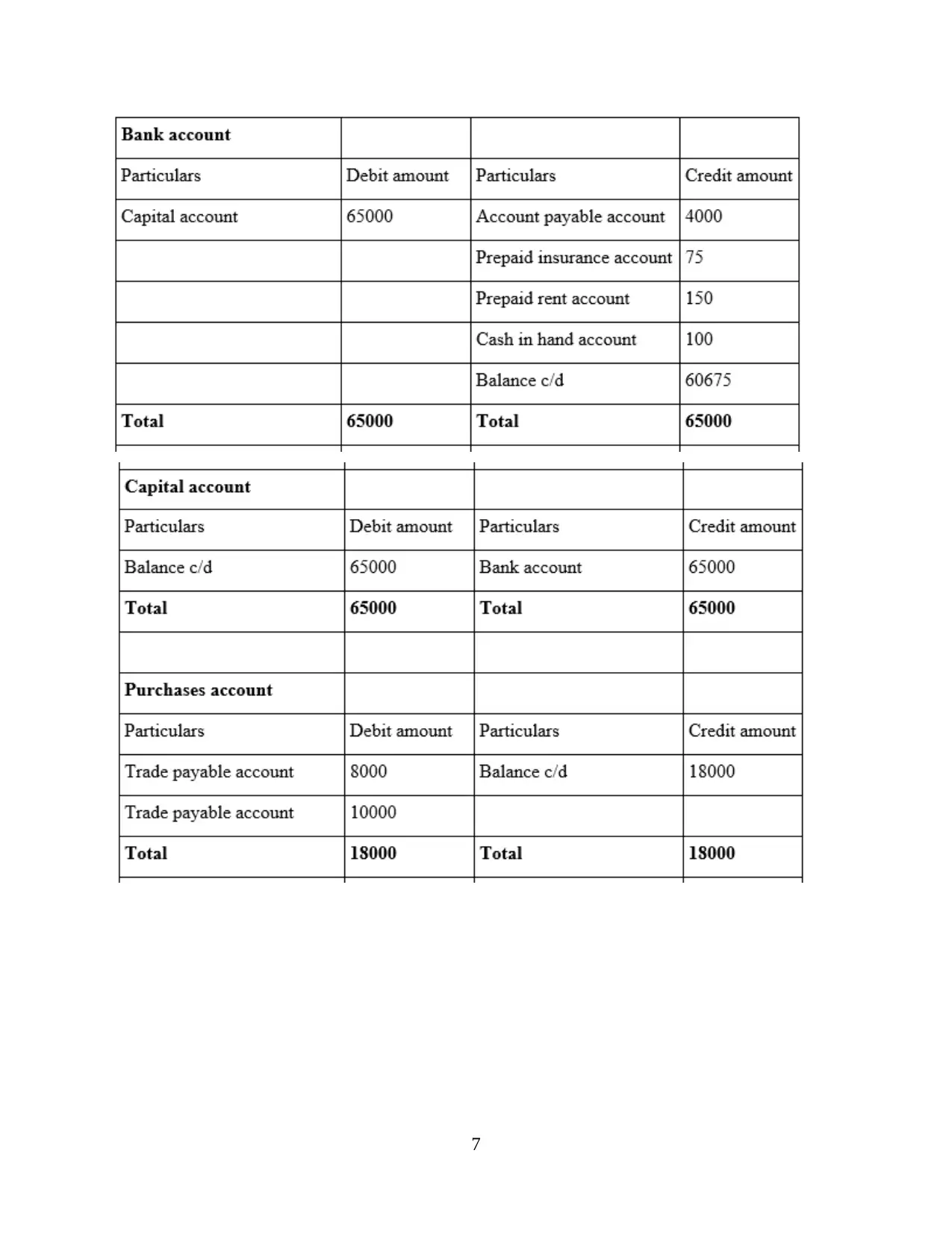
7
Paraphrase This Document
Need a fresh take? Get an instant paraphrase of this document with our AI Paraphraser
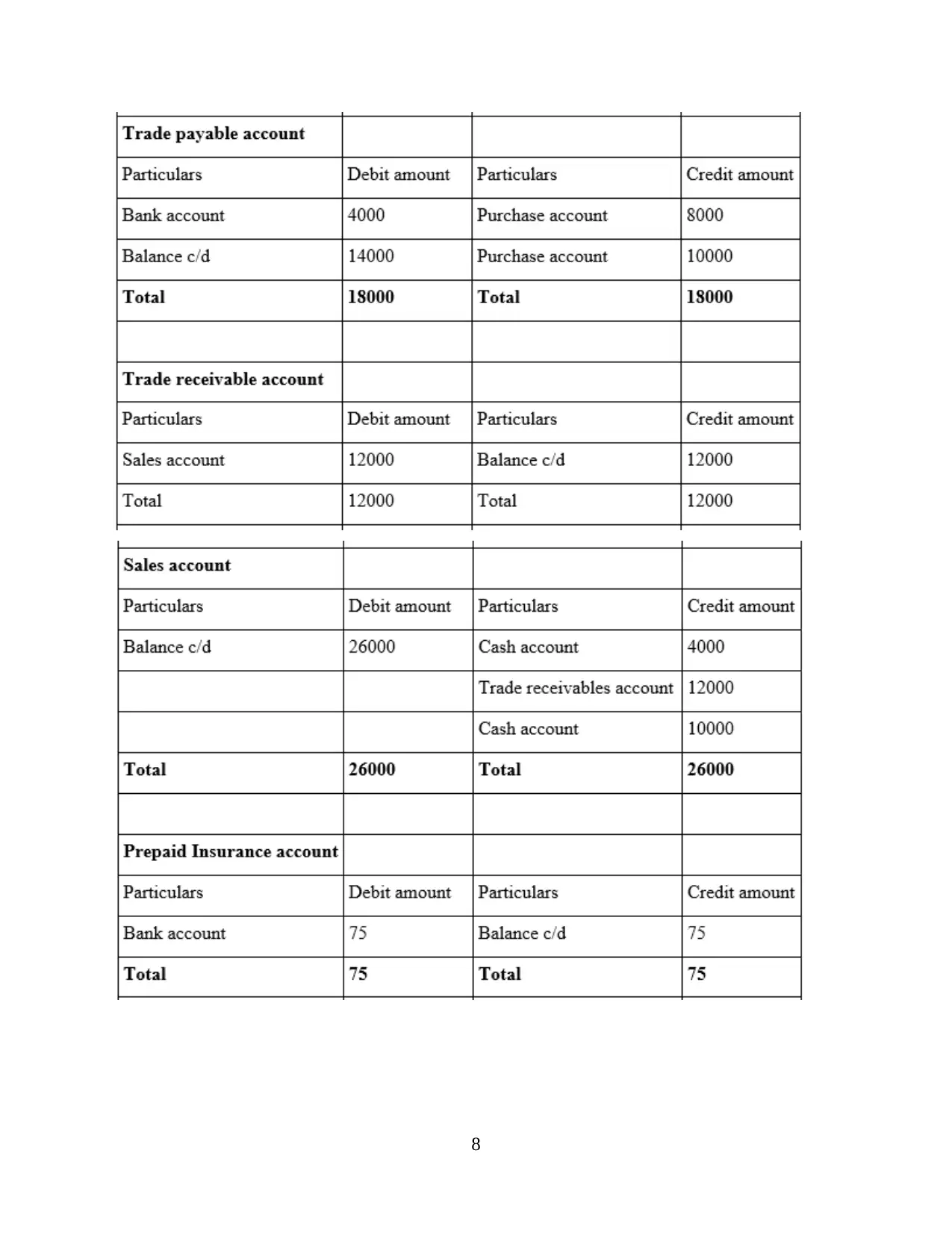
8
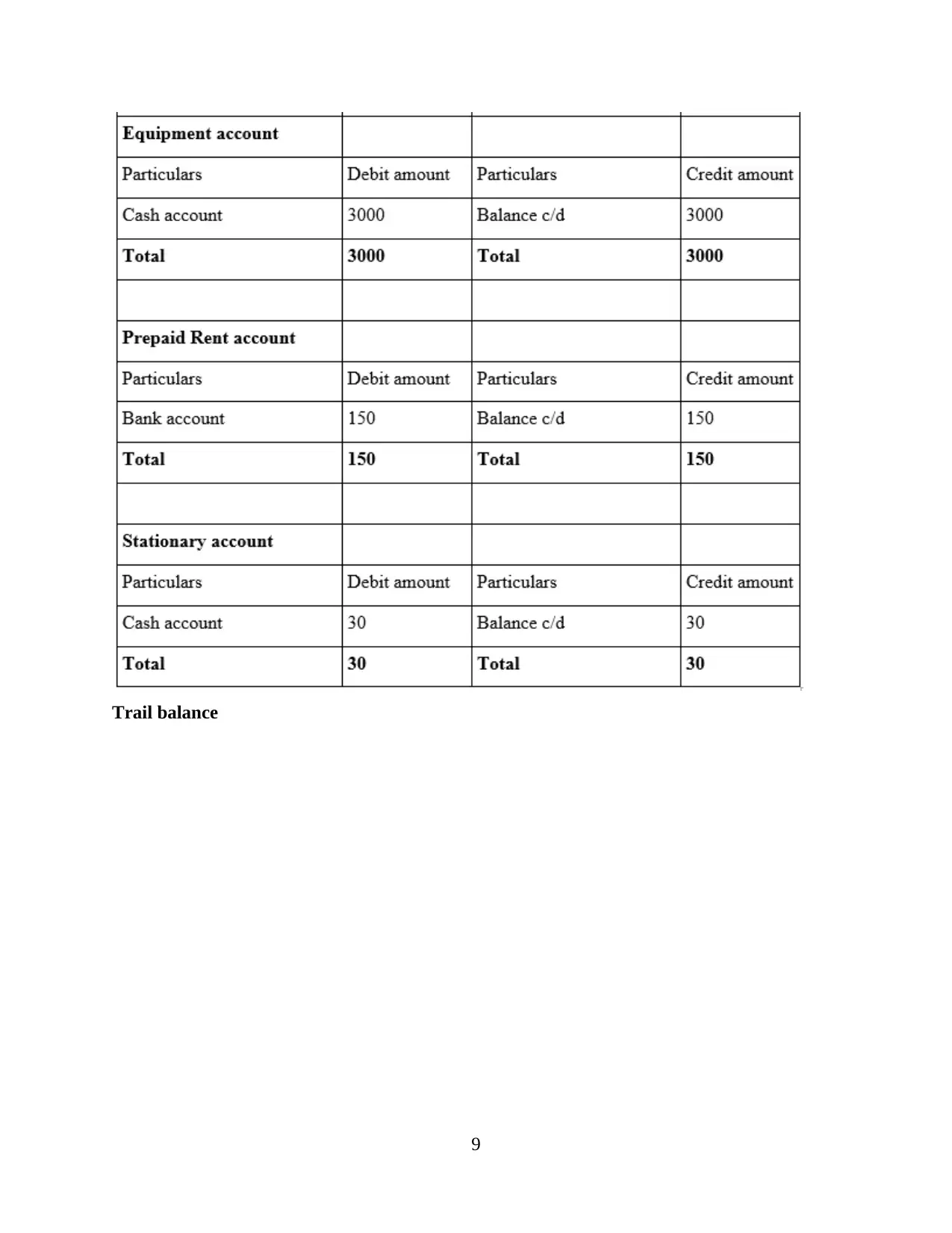
Trail balance
9
9
⊘ This is a preview!⊘
Do you want full access?
Subscribe today to unlock all pages.

Trusted by 1+ million students worldwide
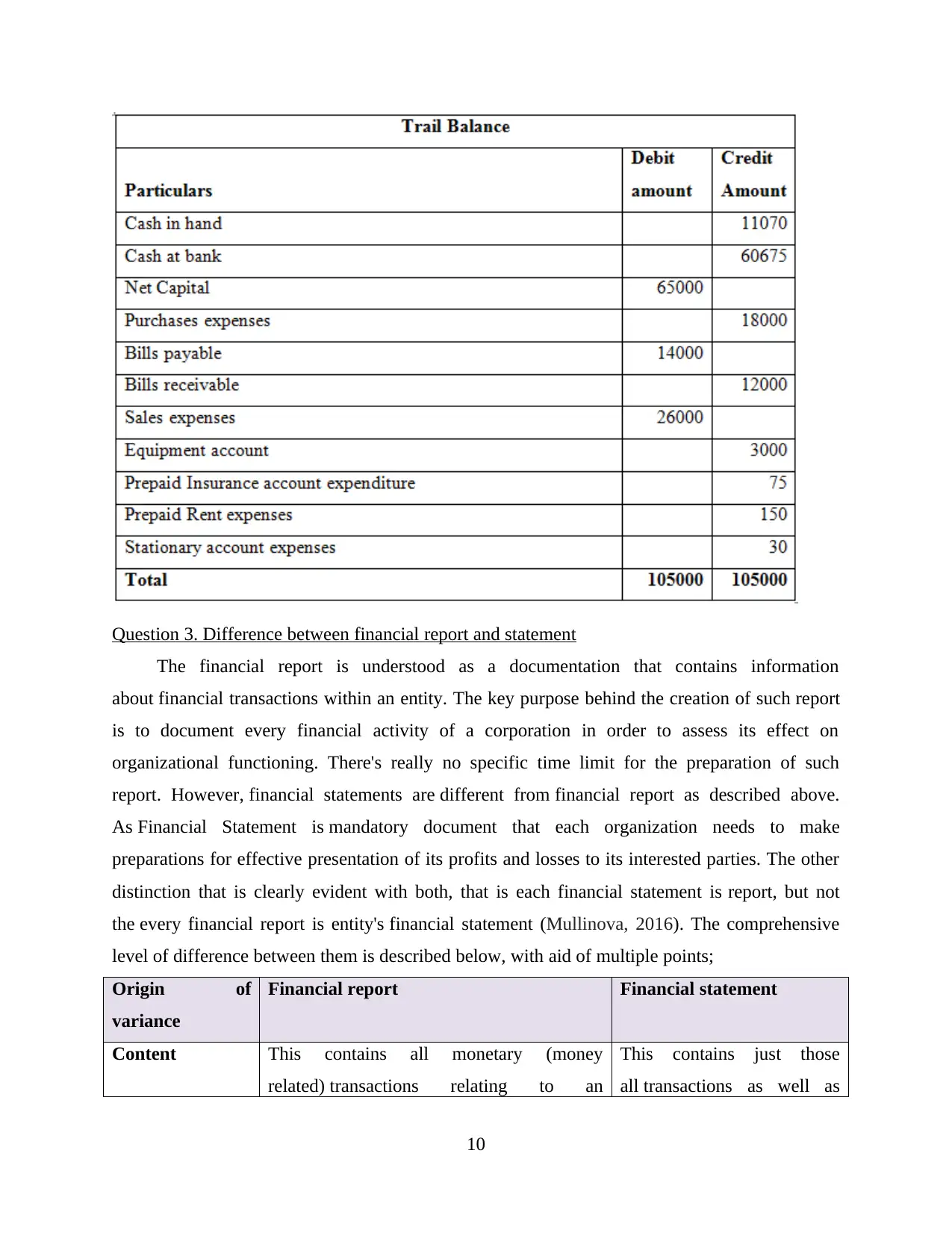
Question 3. Difference between financial report and statement
The financial report is understood as a documentation that contains information
about financial transactions within an entity. The key purpose behind the creation of such report
is to document every financial activity of a corporation in order to assess its effect on
organizational functioning. There's really no specific time limit for the preparation of such
report. However, financial statements are different from financial report as described above.
As Financial Statement is mandatory document that each organization needs to make
preparations for effective presentation of its profits and losses to its interested parties. The other
distinction that is clearly evident with both, that is each financial statement is report, but not
the every financial report is entity's financial statement (Mullinova, 2016). The comprehensive
level of difference between them is described below, with aid of multiple points;
Origin of
variance
Financial report Financial statement
Content This contains all monetary (money
related) transactions relating to an
This contains just those
all transactions as well as
10
The financial report is understood as a documentation that contains information
about financial transactions within an entity. The key purpose behind the creation of such report
is to document every financial activity of a corporation in order to assess its effect on
organizational functioning. There's really no specific time limit for the preparation of such
report. However, financial statements are different from financial report as described above.
As Financial Statement is mandatory document that each organization needs to make
preparations for effective presentation of its profits and losses to its interested parties. The other
distinction that is clearly evident with both, that is each financial statement is report, but not
the every financial report is entity's financial statement (Mullinova, 2016). The comprehensive
level of difference between them is described below, with aid of multiple points;
Origin of
variance
Financial report Financial statement
Content This contains all monetary (money
related) transactions relating to an
This contains just those
all transactions as well as
10
Paraphrase This Document
Need a fresh take? Get an instant paraphrase of this document with our AI Paraphraser
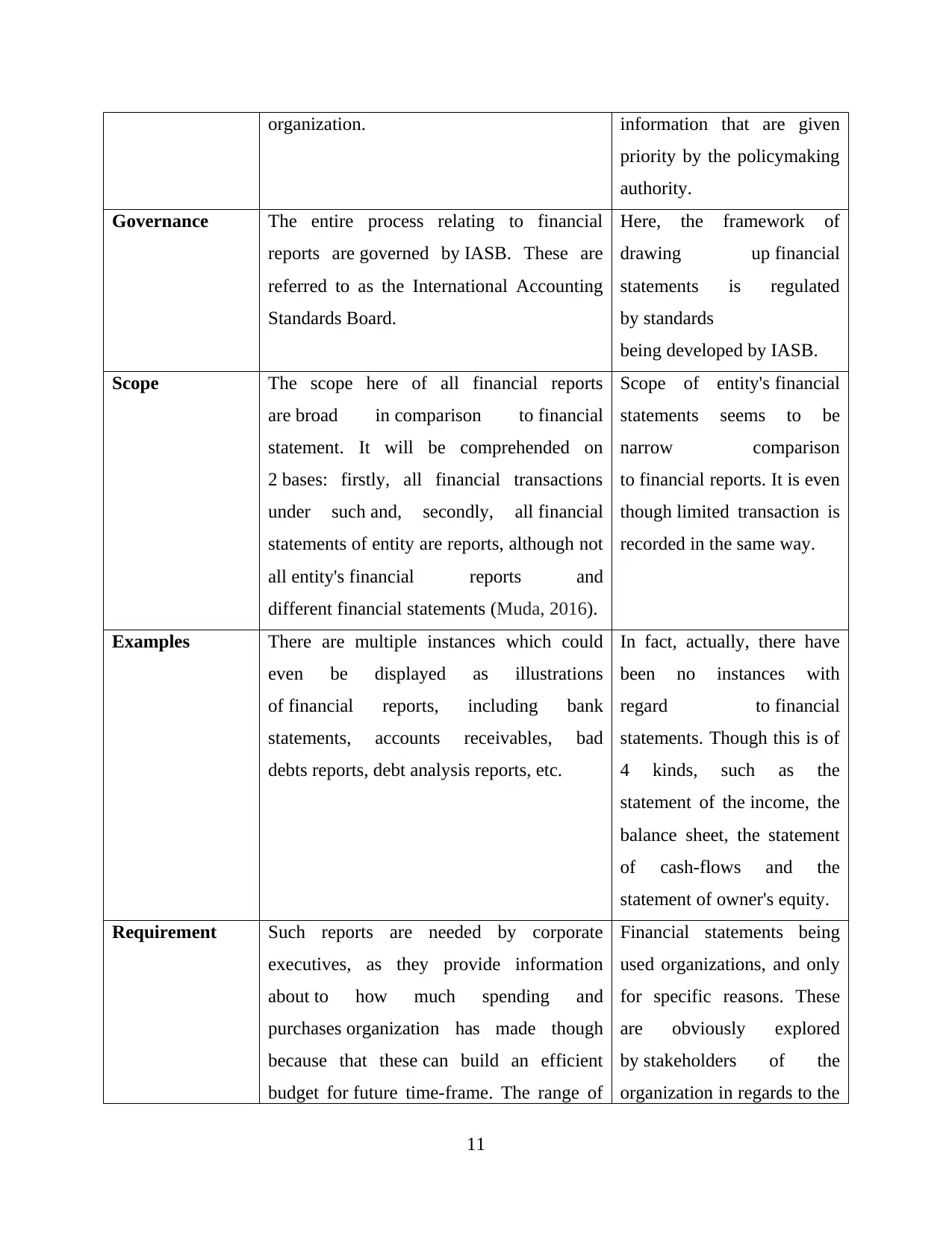
organization. information that are given
priority by the policymaking
authority.
Governance The entire process relating to financial
reports are governed by IASB. These are
referred to as the International Accounting
Standards Board.
Here, the framework of
drawing up financial
statements is regulated
by standards
being developed by IASB.
Scope The scope here of all financial reports
are broad in comparison to financial
statement. It will be comprehended on
2 bases: firstly, all financial transactions
under such and, secondly, all financial
statements of entity are reports, although not
all entity's financial reports and
different financial statements (Muda, 2016).
Scope of entity's financial
statements seems to be
narrow comparison
to financial reports. It is even
though limited transaction is
recorded in the same way.
Examples There are multiple instances which could
even be displayed as illustrations
of financial reports, including bank
statements, accounts receivables, bad
debts reports, debt analysis reports, etc.
In fact, actually, there have
been no instances with
regard to financial
statements. Though this is of
4 kinds, such as the
statement of the income, the
balance sheet, the statement
of cash-flows and the
statement of owner's equity.
Requirement Such reports are needed by corporate
executives, as they provide information
about to how much spending and
purchases organization has made though
because that these can build an efficient
budget for future time-frame. The range of
Financial statements being
used organizations, and only
for specific reasons. These
are obviously explored
by stakeholders of the
organization in regards to the
11
priority by the policymaking
authority.
Governance The entire process relating to financial
reports are governed by IASB. These are
referred to as the International Accounting
Standards Board.
Here, the framework of
drawing up financial
statements is regulated
by standards
being developed by IASB.
Scope The scope here of all financial reports
are broad in comparison to financial
statement. It will be comprehended on
2 bases: firstly, all financial transactions
under such and, secondly, all financial
statements of entity are reports, although not
all entity's financial reports and
different financial statements (Muda, 2016).
Scope of entity's financial
statements seems to be
narrow comparison
to financial reports. It is even
though limited transaction is
recorded in the same way.
Examples There are multiple instances which could
even be displayed as illustrations
of financial reports, including bank
statements, accounts receivables, bad
debts reports, debt analysis reports, etc.
In fact, actually, there have
been no instances with
regard to financial
statements. Though this is of
4 kinds, such as the
statement of the income, the
balance sheet, the statement
of cash-flows and the
statement of owner's equity.
Requirement Such reports are needed by corporate
executives, as they provide information
about to how much spending and
purchases organization has made though
because that these can build an efficient
budget for future time-frame. The range of
Financial statements being
used organizations, and only
for specific reasons. These
are obviously explored
by stakeholders of the
organization in regards to the
11
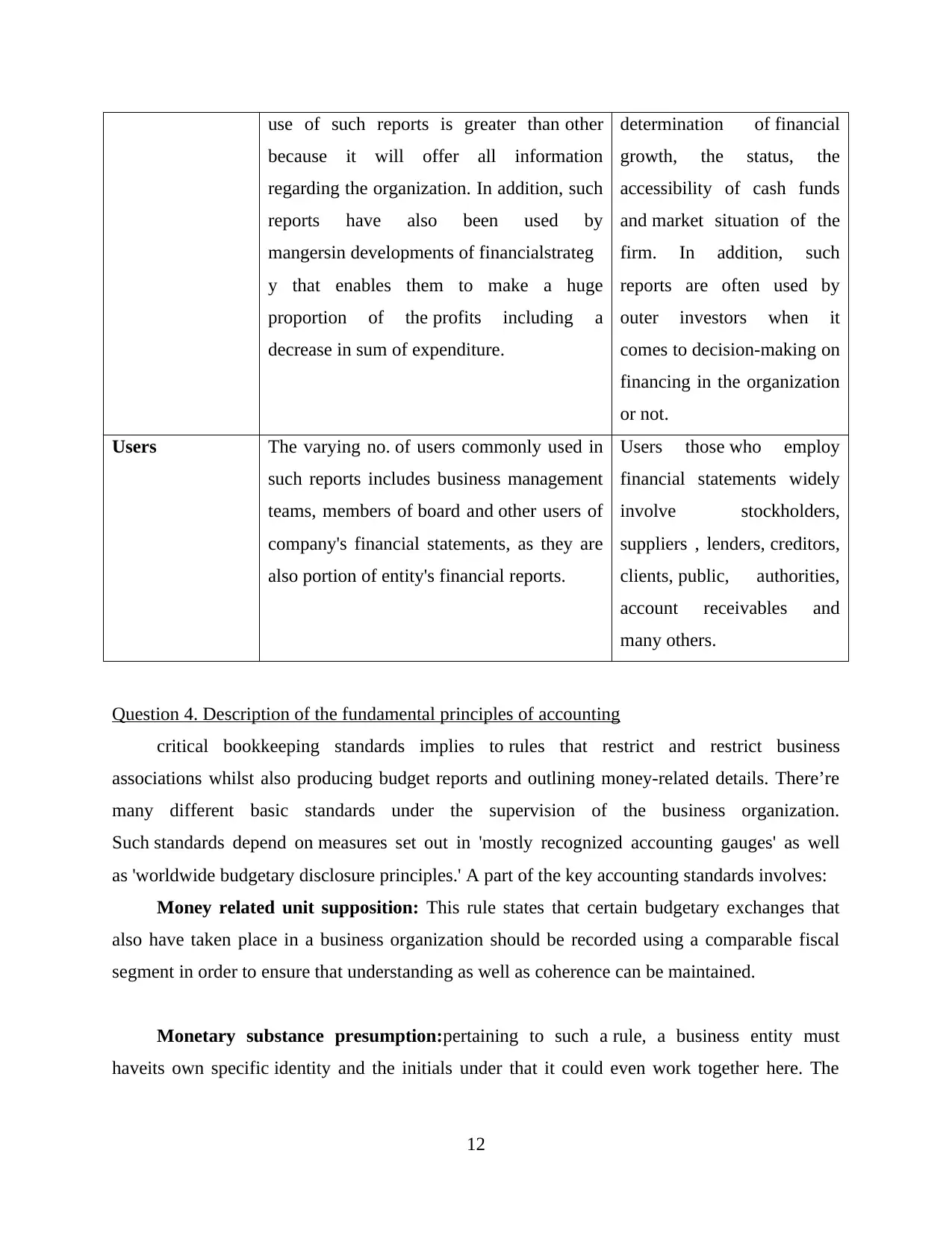
use of such reports is greater than other
because it will offer all information
regarding the organization. In addition, such
reports have also been used by
mangersin developments of financialstrateg
y that enables them to make a huge
proportion of the profits including a
decrease in sum of expenditure.
determination of financial
growth, the status, the
accessibility of cash funds
and market situation of the
firm. In addition, such
reports are often used by
outer investors when it
comes to decision-making on
financing in the organization
or not.
Users The varying no. of users commonly used in
such reports includes business management
teams, members of board and other users of
company's financial statements, as they are
also portion of entity's financial reports.
Users those who employ
financial statements widely
involve stockholders,
suppliers , lenders, creditors,
clients, public, authorities,
account receivables and
many others.
Question 4. Description of the fundamental principles of accounting
critical bookkeeping standards implies to rules that restrict and restrict business
associations whilst also producing budget reports and outlining money-related details. There’re
many different basic standards under the supervision of the business organization.
Such standards depend on measures set out in 'mostly recognized accounting gauges' as well
as 'worldwide budgetary disclosure principles.' A part of the key accounting standards involves:
Money related unit supposition: This rule states that certain budgetary exchanges that
also have taken place in a business organization should be recorded using a comparable fiscal
segment in order to ensure that understanding as well as coherence can be maintained.
Monetary substance presumption:pertaining to such a rule, a business entity must
haveits own specific identity and the initials under that it could even work together here. The
12
because it will offer all information
regarding the organization. In addition, such
reports have also been used by
mangersin developments of financialstrateg
y that enables them to make a huge
proportion of the profits including a
decrease in sum of expenditure.
determination of financial
growth, the status, the
accessibility of cash funds
and market situation of the
firm. In addition, such
reports are often used by
outer investors when it
comes to decision-making on
financing in the organization
or not.
Users The varying no. of users commonly used in
such reports includes business management
teams, members of board and other users of
company's financial statements, as they are
also portion of entity's financial reports.
Users those who employ
financial statements widely
involve stockholders,
suppliers , lenders, creditors,
clients, public, authorities,
account receivables and
many others.
Question 4. Description of the fundamental principles of accounting
critical bookkeeping standards implies to rules that restrict and restrict business
associations whilst also producing budget reports and outlining money-related details. There’re
many different basic standards under the supervision of the business organization.
Such standards depend on measures set out in 'mostly recognized accounting gauges' as well
as 'worldwide budgetary disclosure principles.' A part of the key accounting standards involves:
Money related unit supposition: This rule states that certain budgetary exchanges that
also have taken place in a business organization should be recorded using a comparable fiscal
segment in order to ensure that understanding as well as coherence can be maintained.
Monetary substance presumption:pertaining to such a rule, a business entity must
haveits own specific identity and the initials under that it could even work together here. The
12
⊘ This is a preview!⊘
Do you want full access?
Subscribe today to unlock all pages.

Trusted by 1+ million students worldwide
1 out of 21
Related Documents
Your All-in-One AI-Powered Toolkit for Academic Success.
+13062052269
info@desklib.com
Available 24*7 on WhatsApp / Email
![[object Object]](/_next/static/media/star-bottom.7253800d.svg)
Unlock your academic potential
Copyright © 2020–2025 A2Z Services. All Rights Reserved. Developed and managed by ZUCOL.





